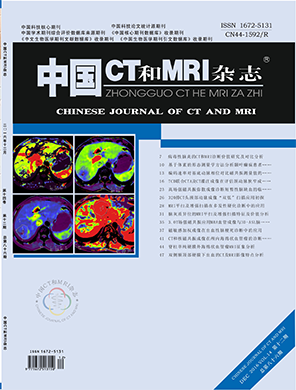摘要
目的 探讨磁敏感加权成像(SWI) 在出血性脑梗死中的诊断价值。方法 选 择2010年12月到2014年12月在我院确诊 的96例出血性脑梗死患者,分别行常规 MRI、扩散加权成像(DWI)和SWI检查,根 据图像分析结果比较不同扫描序列对出 血性脑梗死阳性检出率、出血灶阳性检 出率的差异;测量出血灶面积,采用评 分法评价不同扫描序列对出血面积的差 异。结果 SWI序列对出血性脑梗死的阳 性检出率明显高于T1WI、T2WI、DWI序 列,差异均具有统计学意义(P<0.05)。 SWI序列对出血灶的阳性检出率明显高于 T1WI、T2WI、DWI序列,差异均具有统计 学意义(P<0.05)。SWI序列对出血性脑梗 死出血评分的总分值明显高于T1WI结合 T2WI、DWI序列,差异均具有统计学意义 (P<0.05)。结论 SWI序列相比于常规MRI 序列和DWI序列用于检测出血性脑梗死, 阳性检出率高,可早期检测出脑梗死中的 出血灶,具有一定的鉴别诊断价值。
Objective To investigate the clinical diagnostic value of susceptibility weighted imaging (SWI) in hemorrhagic cerebral infarction. Methods 96 patients with hemorrhagic cerebral infarction of December 2010 to December 2014 in our hospital were examined by 3.0T magnetic resonance imaging (MRI). Conventional MRI, diffusion weighted imaging (DWI) and SWI were performed simultaneously. According to the result of image analysis to compare the positive detection rate of hemorrhagic cerebral infarction and hemorrhage stove with different scanning sequence. Measuring bleeding focal area, scoring method is used to evaluate different scanning sequence differences on the bleeding area. Results The positive detection rate of hemorrhagic cerebral infarction of SWI was significantly higher than T1WI, T2WI, DWI, they have significant difference (P<0.05). The positive detection rate of hemorrhage stove of SWI was obviously higher than T1WI, T2WI, DWI, they have significant difference (P<0.05). The positive detection rate of hemorrhagic cerebral infarction bleeding score total value of SWI was obviously higher than the total value T1WI combined with T2WI, DWI, they have significant difference (P<0.05). Conclusion Compared with the conventional MRI and DWI used to detect hemorrhagic cerebral infarction, SWI has higher positive detection rate, can early detect the focal cerebral infarction in bleeding, it can be used as a routine examination for diagnosis of hemorrhagic cerebral infarction.
【关键词】磁敏感加权成像;出血性脑梗 死;诊断
【中图分类号】R743.3;R445.2
【文献标识码】A
【DOI】
前言
近年来,随着人们生活方式的改变和社会节奏的改变,心脑血 管疾病在人群中的发病率不断攀升,出血性脑梗死在脑血管疾病中 占到高达三分之二的比例[1]。出血性脑梗死(hemorrhagic cerebral infarction)是急性脑血管疾病的类型之一,是指在梗死区域发生的继 发性出血,早期诊断和及时有效治疗对于预后有重要意义[2]。磁敏感 加权成像(susceptility-weighted imaging,SWI)是一种新型的三维采 集成像的序列,其主要作用机制是利用组织磁敏感性不同而成像,对 于静脉结构和血液代谢物质非常敏感,能及时发现少量的出血情况, 故在出血性脑梗死诊断中具有一定的价值[3-4]。本研究通过比较SWI序 列和常规MRI、扩散加权成像(DWI)序列诊断出血性脑梗死,以期为SWI 用于诊断出血性脑梗死提供一定的临床依据。
中国CT和MRI杂志
第14卷, 第 12 期
2016年12月

相关文章